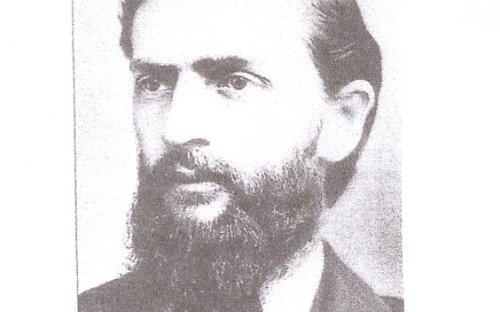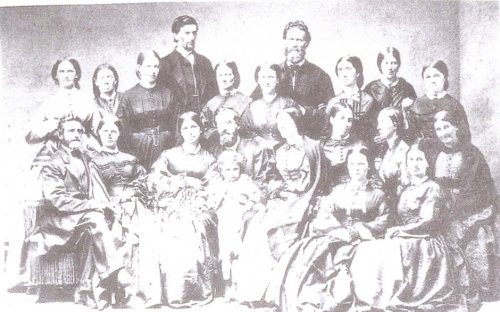Abolitionist
George Lenoard White was born in Cadiz on September 20, 1838. His father Willam was the village blacksmith and his small white house and shop were located on Main Street at the crossing of Ischua Creek. His father was a devoted Baptist who often led village prayers. He believed in the Temperance Movement (prohibiting the use of alcoholic beverages) and was proud to proclaim himself as an Abolitionist.
Abolitionists believed that all men were created free and that no one had the right to own slaves. Several of the families in Cadiz were involved in the Underground Railroad. Slaves would be rafted up Ischua Creek and hidden in the Stagecoach Inn and several nearby houses. A school teacher from Nichols Brook would take them to the next stop by wagon. Among the families involved were the Meads, Burlingames and Searles.
Anyone caught helping slaves escape could be prosecuted, jailed and heavily fined. Authorities expected anyone with knowledge of this activity to report it or face similar penalties. No one was ever caught in Cadiz.
George White attended School #3 in Cadiz and is listed in the attendance books in the 1840's. His friend Aaron Mead's father Merlin was involved in the Abolitionist Movement and the Underground Railroad. As he grew older, George also became and avowed Abolitionist.
When his family moved to Hinsdale, Geogre set off for Ohio where he became a school teacher. He dressed in clerical black, and always carried a rifle and Bible. His height was estimated between 6'5" and 6'7". He wore a black beard, had coarse black hair and blue-gray eyes. He established a school for freed black children in the woods. He feared that the Confederate Army might try to enslave the children he taught and decided it was time to enlist in the Civil War.
He joined the 73rd Infrantry from Virginia and valiantly fought at Chancellorsville, Gettysburg and Lookout Mountain. He became seriously ill with consumption and was hospitalized for several months. This condition would affect him for the remainder of his life. Unable to rejoin the 73rd, he was made a regimental band director when they realized that he was a musical genius. He had inherited this gift from his father. George played the fiddle and had a unique talent for being a choir director and band leader.
After George was discharged, he went to Nashville, Tennessee where he was hired at Fisk University, a school for freed slaves. He taught music and penmanship.
In 1867 he married Laura Craveth, a teacher at the school. Her brother Erastus was the school director. He appointed George as the treasurer of Fisk. The staff realized that they were in deep financial difficulties. The old buildings of Fish had at one time been a hospital for Union Soldiers during the war. These buildings were now crumbling. Teachers put up hundreds of preserves to help feed the students. Although the tuition was low, students struggled to find the resources. Teachers went months without pay. George came upon a plan to try to raise money for Fisk and make it financially stable. He formed a choir of young freed slaves and decided to take them on a concert tour throughtout the United States. He felt it was important to save the spirituals and hymns of the former slaves and had their music transcribed. Hundreds of songs were saved because previously they were passed on only by song and never recorded.
George used his own savings to help organize the tours. He named the choir The Jubilee Singers. They overcame incredible obstacles. They were often denied hotel rooms and were banned in some places from using restuarant dining rooms. They were jeered and threatened by the Ku Klux Klan. In one city they female choir members were forced to sleep in a woodshed. They did not have proper clothing for inclement weather and George borrowed money to buy coats. One of the women was traveling wearing only cloth slippers.
The Jubilee Singers depended on donations from people who came to the concert. Sometimes people were generous and at other times they barely had enough money to cover expenses. Their fame began to spread and eventually the concert halls were full. They were invited to perform in front of prominent people and even presidents. Slowly they began to see a profit.
The next major step was to take the choir on a tour of Europe where they performed in front of royalty. During on of the tours George fell from the platform and suffered injuries causing him to walk with crutches for the rest of his life. His wife and children traveled with him. While in Scotland his wife died suddenly. George also began to suffer from consumption. Despite his poor health and crippled body, he continued with the fund-raising concerts.
Eventually he was forced to retire and moved to Fredonia, New York with is second wife Susan Gilbert who had also been a teacher at Fisk. Through the years of concerts, he and the Jubilee Singers raised $150,000 for the University. Today that would be equivalent to two and a half million dollars. Ironically, despite all his efforts to raise money for others he died a poor man. His wife was forced to find work as a housekeeper since his health was so broken.
On November 8, 1895 George White suffered a massive stroke and died at the age of 58. He is buried in Fredonia. At his memorial service the Jubilee Singers sang "Steal Away" and "We Shall Walk Through the Valley". Georgia Gordon, one of his singers said: "He was the true and tried friend of the singers and a staunch friend of the negro race."
Many music experts credit George White with saving many of the spirituals and hymns of the slaves and keeping them from oblivion. Perhaps one of the most famous is "Swing Low Sweet Chariot", said to have been composed by the mother of one of the Jubilee Singers.
Read another article from a local newspaper about George L. White.
Written by - Maggie Fredrickson




